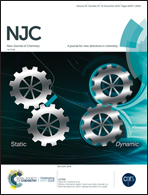Catalytic NO reduction by CO over ceria–cobalt oxide catalysts†
Abstract
A series of ceria–cobalt oxide (Co100−xCex) catalysts with controlled metal molar ratios were tested for the catalytic performance of NO reduction by CO. The structural property, and surface chemistry were investigated by nitrogen adsorption, X-ray diffraction, scanning electron microscopy, high-resolution transmission electron microscopy, X-ray photo-electron spectroscopy, and temperature-programmed reduction by hydrogen. The flow reactor studies revealed that the Co98Ce2 catalyst can achieve 99% N2 selectivity at a relatively low temperature (260 °C), and the Co15Ce85 catalyst exhibits ∼100% N2 selectivity at a high temperature (580 °C). Notably, the tandem use of Co98Ce2 and Co15Ce85 catalysts (molar ratio 1 : 1) achieved 99.6% conversion of NO and 99.7% selectivity of N2 for a wide temperature range from 250 to 680 °C. The synergistic effects of Ce and Co were evidenced in this work. The Co2+/Co3+ ratio was increased with 2% Ce incorporation, which could promote NO adsorption at low temperature; the Ce–O–Co solid solution formed rich surface oxygen that may promote CO oxidation through the Mars–van Krevelen mechanism on surfaces and oxygen vacancies would be replenished when adsorbed NO molecules were reduced to N2. The rich O/(Ce + Co), Co2+/Co3+, and Ce4+/Ce3+ pairs on the surface of Co100−xCex promoted sustainable activity for NO decomposition to N2. This study provides a promising avenue for boosting the conversion of polluted exhaust gas via designing suitable tandem catalysis systems.



 Please wait while we load your content...
Please wait while we load your content...